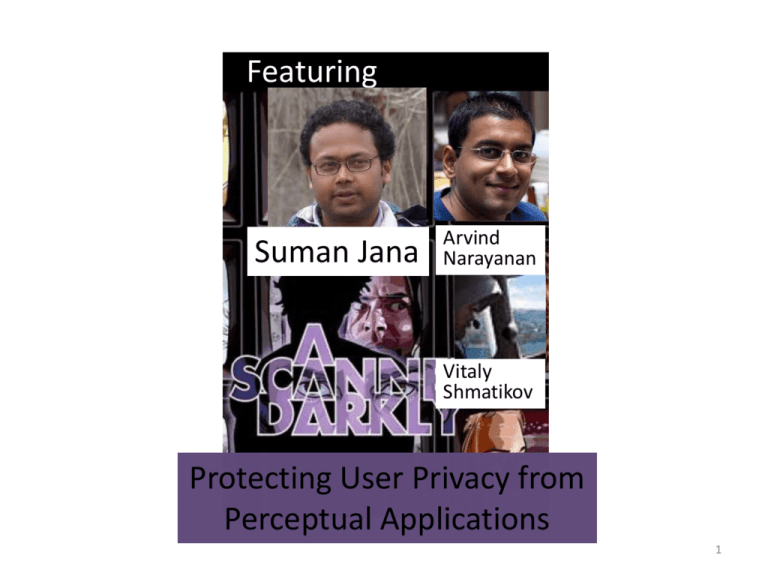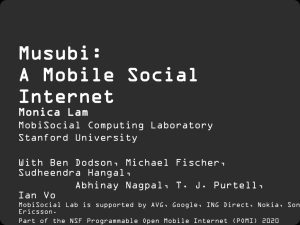pptx - Suman Jana
advertisement

Featuring Suman Jana Arvind Narayanan Vitaly Shmatikov Protecting User Privacy from Perceptual Applications 1 The Future of Computing? What does this all mean for a security & privacy researcher? 2 They Are Watching… 3 They Are Running Untrusted Code… “… Your robots are always up-to-date with the coolest apps” 200+ projects on GitHub Augmented-reality apps on mobile phones 4 Privacy Risks Hierarchy of Perceptual Apps Over-collection of data Sensitive items (e.g. credit cards, license plates…) increasing sophistication Aggregation, tracking and surveillance Semantic inference - patterns of movement and proximity, contexts… 5 Non-Solutions • Block access to perceptual inputs? – The whole purpose of these apps is to analyze and use information about their environment! • Anonymize collected data? – How to “anonymize” the video feed of a room? • Differential privacy? – Uh-huh 6 This is unusual Introducing Darkly • Domain- and data-specific system for protecting user privacy from perceptual apps – Exploits typical structure of perceptual software • Integrated with a popular computer vision library for maximum portability • (Almost) transparent to existing software • “Defense in depth” – Access control + algorithmic privacy transforms + user audit 7 Structure of Perceptual Apps perceptual app computer vision library very hard! 8 Intuition Behind Darkly privacy protection layer perceptual app computer vision library right level of library API remains abstraction unchanged 9 Architecture of Darkly standard OS user isolation Darkly process app interposition library Darkly server trusted input sensors, OS, hardware computer vision library application 10 OpenCV: Darkly’s Vision Library Robot OS 11 Defense #1: Access Control • Replace pointers to pixel data with opaque references • OpenCV functions can dereference internally, operate on raw data without loss of fidelity • Applications cannot dereference – Most of our benchmark applications still work correctly without any modifications – They never access pixel data, just pass it back and forth to OpenCV functions! 12 Darkly Facilities: Trusted GUI & Remote Storage • Without accessing raw inputs, apps can … – Display pixel data to user, operate on user input (mouse, keystrokes), store data to remote storage • Examples: Security cam detects movement, shows raw image to the user/stores it in remote storage without accessing pixel data 13 Access to Image Features • Some applications do need access to the image but are only interested in certain features – A security surveillance app needs object contours to detect movement – A QR code scanner needs black-and-white matrix 14 Defense #2: Privacy Transforms App makes OpenCV calls to obtain image features cvMoments cvFindContours cvHaarDetectObjects … Darkly applies feature-specific but application-independent transforms to OpenCV’s answers 15 An Example Transform: Sketching • Blurring (box filter), then contour detection – Idea: preserve large-scale features only 16 Effect on Applications • For many apps, accuracy is not affected! • For some apps, quantifiable tradeoff between the amount of transformation and accuracy – For example, surveillance app may miss smaller motions with larger amount of transformation – User controls how much transformation to apply 17 But My App Needs Raw Pixels… • Example: eigenface-based face recognizer Darkly will execute arbitrary app-provided code, as long as it’s written in ibc language Based on GNU bc Almost pure computation No access to syscalls, network, sys time Single 32-bit return value Easy to sandbox! 18 Defense #3: User Audit • Console window shows to the user the outputs of transforms, now and over time Privacy dial from 0 to 11 lets the user adjust the degree of transformation Raw input Darkly console view 19 A Complete Example: Ball-Tracking Robot Dog 20 A Complete Example: Ball-Tracking Robot Dog Opaque references Apply sketching transform 21 Ball-Tracking Robot Dog: Console View Raw input Darkly console view 22 Evaluation • 20 open-source OpenCV applications – Object recognizers and trackers, QR decoder, security cam, facial features recognizer, corner and edge finders, histogram calculators…. • 18 out of 20 run without any modifications! • Negligible performance overhead (< 3%) • Tradeoffs between accuracy and privacy, but all apps still fully functional 23 Hierarchy of Perceptual Privacy Risks Revisited Over-collection of data Sensitive items (e.g. credit cards, license plates…) Aggregation, tracking and surveillance Semantic inference - patterns of movement and proximity, contexts… 24 Questions 25





